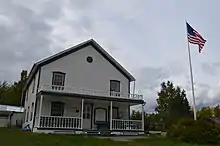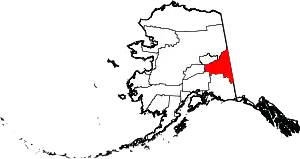Southeast Fairbanks Census Area, Alaska
Southeast Fairbanks Census Area is a census area located in the U.S. state of Alaska. As of the 2020 census, the population was 6,808, down from 7,029 in 2010.[2][3] It is part of the unorganized borough and therefore has no borough seat. Its largest communities are Deltana and Tok, both unincorporated CDPs.
Southeast Fairbanks Census Area | |
|---|---|
 Historic Courthouse in Eagle, Alaska. | |
 Location within the U.S. state of Alaska | |
.svg.png.webp) Alaska's location within the U.S. | |
| Coordinates: 63°46′N 143°36′W | |
| Country | |
| State | |
| Established | 1980[1] |
| Named for | its location to the southeast of Fairbanks, Alaska |
| Largest CDP | Deltana |
| Area | |
| • Total | 25,059 sq mi (64,900 km2) |
| • Land | 24,769 sq mi (64,150 km2) |
| • Water | 291 sq mi (750 km2) 1.2% |
| Population (2020) | |
| • Total | 7,021 |
| • Density | 0.28/sq mi (0.11/km2) |
| Time zone | UTC−9 (Alaska) |
| • Summer (DST) | UTC−8 (ADT) |
| Congressional district | At-large |
Geography
According to the U.S. Census Bureau, the census area has a total area of 25,059 square miles (64,900 km2), of which 24,769 square miles (64,150 km2) is land and 291 square miles (750 km2) (1.2%) is water.[4] For comparison, it is slightly bigger than the state of West Virginia.
Adjacent boroughs and census areas
- Fairbanks North Star Borough, Alaska – Northwest
- Yukon-Koyukuk Census Area, Alaska – North
- Copper River Census Area, Alaska – South
- Matanuska-Susitna Borough, Alaska – Southwest
- Denali Borough, Alaska – West
- Yukon Territory, Canada – East
National protected areas
Politics
Southeast Fairbanks is one of the most Republican parts of Alaska, frequently giving Republican candidates well over 70% of the vote.
| Year | Republican | Democratic | Third party | |||
|---|---|---|---|---|---|---|
| No. | % | No. | % | No. | % | |
| 2020 | 2,823 | 76.19% | 748 | 20.19% | 134 | 3.62% |
| 2016 | 2,441 | 71.10% | 669 | 19.49% | 323 | 9.41% |
| 2012 | 2,249 | 72.81% | 680 | 22.01% | 160 | 5.18% |
| 2008 | 2,766 | 79.80% | 700 | 20.20% | 0 | 0.00% |
| 2004 | 1,668 | 77.01% | 414 | 19.11% | 84 | 3.88% |
| 2000 | 2,128 | 73.71% | 471 | 16.31% | 288 | 9.98% |
| 1996 | 1,532 | 61.50% | 563 | 22.60% | 396 | 15.90% |
| 1992 | 1,158 | 43.91% | 525 | 19.91% | 954 | 36.18% |
| 1988 | 1,522 | 67.58% | 588 | 26.11% | 142 | 6.31% |
| 1984 | 1,855 | 77.10% | 457 | 18.99% | 94 | 3.91% |
| 1980 | 1,158 | 59.08% | 374 | 19.08% | 428 | 21.84% |
| 1976 | 803 | 53.93% | 558 | 37.47% | 128 | 8.60% |
| 1972 | 562 | 59.28% | 278 | 29.32% | 108 | 11.39% |
| 1968 | 454 | 49.13% | 287 | 31.06% | 183 | 19.81% |
| 1964 | 258 | 32.74% | 530 | 67.26% | 0 | 0.00% |
| 1960 | 365 | 55.14% | 297 | 44.86% | 0 | 0.00% |
Demographics
| Census | Pop. | Note | %± |
|---|---|---|---|
| 1970 | 4,179 | — | |
| 1980 | 5,676 | 35.8% | |
| 1990 | 5,913 | 4.2% | |
| 2000 | 6,174 | 4.4% | |
| 2010 | 7,029 | 13.8% | |
| 2020 | 6,808 | −3.1% | |
| U.S. Decennial Census[6] 1900–1990[7] 1990–2000[8] 2010–2020[2][3] | |||
As of the census[9] of 2000, there were 6,174 people, 2,098 households, and 1,506 families living in the census area. The population density was 0.25 people per square mile (0.097 people/km2). There were 3,225 housing units at an average density of 0.13 per square mile (0.050/km2). The racial makeup of the census area was 78.99% White, 1.98% Black or African American, 12.71% Native American, 0.68% Asian, 0.15% Pacific Islander, 0.73% from other races, and 4.76% from two or more races. 2.70% of the population were Hispanic or Latino of any race. 4.29% reported speaking an Athabaskan language at home, while 4.02% speak Russian, 3.76% Ukrainian, and 2.34% Spanish.[10]
Of the 2,098 households, 39.40% had children under the age of 18 living with them, 58.20% were married couples living together, 8.60% had a female householder with no husband present, and 28.20% were non-families. 23.50% of households were one person, and 5.50% were one person aged 65 or older. The average household size was 2.80 and the average family size was 3.34.
In the census area, the population was spread out, with 32.80% under the age of 18, 7.60% from 18 to 24, 27.80% from 25 to 44, 25.70% from 45 to 64, and 6.10% 65 or older. The median age was 34 years. For every 100 females, there were 107.20 males. For every 100 females age 18 and over, there were 108.60 males.
2020 Census
| Race | Percentage of Population |
|---|---|
| White | 82.70% |
| Black or African American | 1.87% |
| American Indian or Alaska Native | 16.64% |
| Asian | 2.75% |
| Native Hawaiian and Other Pacific Islander | 1.10% |
| Some other race | 4.48% |
Communities
Cities
Census-designated places
References
- In 1980, the United States Census Bureau divided the Unorganized Borough into 12 census areas.
- "2020 Census Data - Cities and Census Designated Places" (Web). State of Alaska, Department of Labor and Workforce Development. Retrieved October 31, 2021.
- "State & County QuickFacts". United States Census Bureau. Archived from the original on May 19, 2014. Retrieved May 18, 2014.
- "US Gazetteer files: 2010, 2000, and 1990". United States Census Bureau. February 12, 2011. Retrieved April 23, 2011.
- Elections, RRH (February 2, 2018). "RRH Elections". rrhelections.com. Retrieved January 12, 2020.
- "U.S. Decennial Census". United States Census Bureau. Retrieved May 18, 2014.
- "Population of Counties by Decennial Census: 1900 to 1990". United States Census Bureau. Retrieved May 18, 2014.
- "Census 2000 PHC-T-4. Ranking Tables for Counties: 1990 and 2000" (PDF). United States Census Bureau. Archived (PDF) from the original on October 9, 2022. Retrieved May 18, 2014.
- "U.S. Census website". United States Census Bureau. Retrieved May 14, 2011.
- Language Map Data Center. Mla.org (April 3, 2013). Retrieved on August 2, 2013.
- "2020 Census Demographic Data Map Viewer".
External links
- Census Area map, 2000 census: Alaska Department of Labor
- Census Area map, 2010 census: Alaska Department of Labor
![]() Media related to Southeast Fairbanks Census Area, Alaska at Wikimedia Commons
Media related to Southeast Fairbanks Census Area, Alaska at Wikimedia Commons